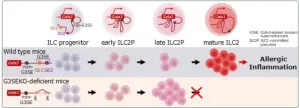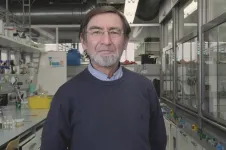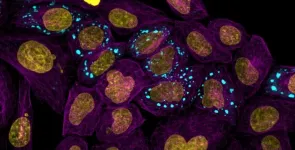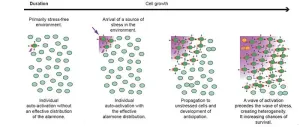(Press-News.org)
Overproduction of Group 2 innate lymphoid cells or ILC2s—a type of white blood cells—can sometimes exacerbate conditions such as bronchial asthma, chronic rhinosinusitis, atopic dermatitis, and organ fibrosis through an exaggerated immune response. Although there are immunomodulatory drugs that can suppress Type 2 helper T (Th2) cells, drugs capable of suppressing ILC2s are currently lacking.
Now, however, in a breakthrough study that could lead to the development of a new therapeutic strategy targeting ILC2s, researchers led by Associate Professor Arifumi Iwata of the Chiba University Hospital, Japan, have identified molecular processes crucial for the maturation of ILC2s. “Although it is clear that Th2 cells and ILC2 play a central role in allergic diseases, the mechanisms of Th2 differentiation and ILC2 development in vivo were largely unknown,” says Dr. Iwata, while explaining the rationale behind the study. Along with Dr. Iwata, Hiroki Furuya, Yosuke Toda, and Hiroshi Nakajima, all from the Graduate School of Medicine at Chiba University, were a part of this study published in Nature Communications on July 5, 2024.
“Since allergic diseases can flare up after discontinuation of current Type 2 cytokine inhibitor drugs, we undertook this study to elucidate and control the upstream regulation of Type 2 cytokine production, i.e., the in vivo Th2 cell differentiation and ILC2 development mechanisms, which we believe are important issues in the control of allergic disease,” adds Dr. Iwata, explaining the specifics of their study further.
All white cells originate from ‘precursors cells,’ which are cells capable of differentiating into B cells, T cells, and innate lymphoid cells (ILCs), including ILC2s. GATA3, a protein produced by the GATA3 gene in humans, is crucial for the proper conversion of precursor cells into ILC2s. In this study, the team of researchers discovered that regulatory regions in the genome, located at 500–764 kb downstream from the Gata3, called GATA3-related tandem super-enhancers or G3SE, are responsible for elevating levels of GATA3 in the bone marrow, which further leads to the conversion of precursor cells to ILC2s.
Using genetically modified G3SE-deficient mice and with methods such as single-cell RNA sequencing and flow cytometry, they found that the GATA3 induction mechanism is crucial during a late stage in ILC2 production. Since the mice lack G3SE, GATA3 levels did not spike sufficiently during this stage in precursor maturation, and as a result, the researchers found the G3SE-deficient mice had significantly low levels of ILC2s.
“We discovered a novel late ILC2-committed precursor stage in the ILC2 differentiation. We also found that the induction of GATA3 expression by an ILC2-specific GATA3 super-enhancers is essential for the differentiation of late ILC2-committed precursors to mature ILC2,” says Dr. Iwata, while talking about the results.
However, on comparing cells from wild-type mice and those from G3SE-deficient mice, the researchers found that the elevation in GATA3 induces ILC2 differentiation through an intermediate step, where levels of a protein called CNOT6L increase. Therefore, targeting the gene that produced this protein could reduce levels of ILC2 in the body. These findings suggest that in the future, gene therapies that target CNOT6L may help avoid exaggerated immune responses due to ILC2s, helping manage a range of diseases.
“While these findings do not directly manage to change the lives of patients, further elucidation of the ILC2-specific differentiation mechanism and development of regulatory mechanisms identified in this study can help develop novel and curative therapies for refractory pathologies of allergic diseases,” concludes a hopeful Dr. Iwata.
About Associate Professor Arifumi Iwata
Dr. Arifumi Iwata is currently an Associate Professor at Chiba University Hospital, Japan. Dr. Iwata has published over 43 scientific articles in the fields of allergy, rheumatology, immunology and genetics, with a focus on inflammation, immunomodulation, molecular pathways of gene expression, therapeutic molecular targets, and others. Dr. Iwata is also a review editor for the journal Frontiers in Immunology.
END
The Specialised Group on Chemistry of Natural Products (GQPN) of the Spanish Royal Society of Chemistry (RSEQ) has awarded its Excellence in Research Award 2023 to Professor Ricardo Riguera. The Evaluation Committee thus recognises his valuable contribution to this area of chemistry. Among other advances, his work has made it possible to describe a large number of bioactive metabolites, such as the first heptacyclopeptide and the first cyclodepsipeptide isolated from marine organisms. Riguera also identified one of the first examples of cytotoxic metabolites from marine bacteria, the first description of L-galactose as part of a natural product, and the first description ...
FINDINGS
A UCLA-led team has developed a machine-learning model that can predict with a high degree of accuracy the short-term survival of dialysis patients on Continuous Renal Replacement Therapy (CRRT).
BACKGROUND
CRRT is a therapy used for very sick hospitalized patients whose health status makes them ineligible for regular hemodialysis. It is a gentler therapy that provides continuous treatment over a prolonged period. About half of adults placed on CRRT, however, do not survive, rendering the treatment futile for both patients ...
Poverty and mental illness are not only linked, but there is also a causal relationship. This is the conclusion of researchers from Amsterdam UMC, the University of Edinburgh and the University of Modena. Their study shows that while certain mental health issues can hinder financial stability, poverty is also one of the causal factors leading to mental health problems. This study was published today in Nature Human Behaviour.
"This study indicates that certain mental health problems can make a person's financial situation uncertain. But conversely, we also see that poverty can lead to mental health problems," ...
Scientists at the University of Cambridge have developed an atlas of proteins describing how they behave inside human cells. This tool could be used to search for the origins of diseases which are related to proteins misbehaving such as dementia and many cancers.
The atlas, which is published in Nature Communications, has allowed the researchers to find new proteins inside cells that are responsible for a range of important bodily functions. The team focuses on a droplet-like part of the cell called a condensate ...
When confronted with an antibiotic, toxic substance, or other source of considerable stress, bacteria are able to activate a defence mechanism using cell-to-cell communication to ‘warn’ unaffected bacteria, which can then anticipate, shield themselves and spread the warning signal. This mechanism1 has just been described for the first time by a team of scientists2 from CNRS and Université de Toulouse III – Paul Sabatier. It paves the way for the development of new, more effective antibiotic treatments that can target this bacterial communication system.
When they perceive a source of stress, bacteria spring into action, inducing changes in the expression of certain ...
The capacity of Mozambican woodlands to capture and store carbon is underestimated and potentially undervalued for their protection and restoration, finds new research from an international team of scientists including UCL researchers and led by carbon data provider Sylvera.
The research, published in Nature Communications Earth & Environment, found that miombo woodlands, which span large areas of Sub-Saharan Africa, store 1.5 to 2.2 times more carbon than had previously been estimated by standard methods.
Named for the miombo trees found in the region, these biomes (geographical areas defined by their local species and ...
Cutting farm nitrous oxide emissions helps climate and ozone layer
Adding crushed basalt rocks and special fertilisers can reduce potent nitrous oxide (N2O) greenhouse gas emissions and safeguard the stratospheric ozone layer, which protects us from harmful UV light and reduces nitrate leaching into water bodies protecting ecosystems and human health
The new study, led by researchers at the University of Sheffield, highlights methods for reducing N2O emissions, such as enhanced weathering of agricultural soils with ...
Drugs developed to fight blood and other cancers could also help improve the efficiency of radiotherapy in the most commonly diagnosed low-grade brain tumour in adults, a new study has found.
Meningioma account for approximately 36% of all primary brain tumours. The majority are successfully treated by surgery, but some which can’t easily be accessed need to be treated with radiotherapy. That can cause significant side effects and radiation damage to the brain, while resistance to radiotherapy can also result in tumour growth.
A new study by researchers at the Brain Tumour Research ...
New research published in Arthritis & Rheumatology indicates that chronic exposure to air pollutants may increase the risk of developing lupus, an autoimmune disease that affects multiple organs.
For the study, investigators analyzed data on 459,815 participants from the UK Biobank. A total of 399 lupus cases were identified during a median follow-up of 11.77 years. Air pollutant exposure was linked with a greater likelihood of developing lupus. Individuals with a high genetic risk and high air pollution exposure had the highest risk of developing ...
Anthracnose, a severe disease caused by the Colletotrichum spinaciae plant pathogen, often occurs in common vetch, a widely grown legume. Chemicals are not recommended for disease management because the plants are used as livestock feed. A new study published in Grassland Research reveals that treating common vetch with certain bacteria or fungi that promote plant growth may be effective for combating anthracnose.
Treating common vetch with these bacteria or fungi increased the activity of plant defense enzymes and promoted the presence of healthy bacteria that could keep Colletotrichum spinaciae at bay.
“The combined use of plant growth‐promoting rhizobacteria such as Bacillus ...




